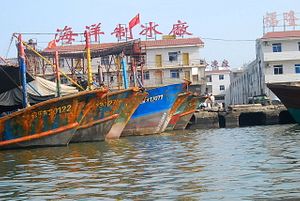China is building a new South China Sea fishing fleet for its maritime militia in a move that could intensify regional disputes, an expert told a conference at the Center for Naval Analyses (CNA) Wednesday.
China’s maritime militia – one of the more understudied agencies in the exercise of Chinese maritime power – typically uses civilian fishing vessels for a range of missions from rescuing stranded vessels to conducting controversial island landings. While voices in China have long called for their inclusion in activities, this would be the first time that the militia would get its own fishing fleet, a boost for the world’s largest producer and exporter of fish and consumer of seafood.
“It appears that China is building a state-owned fishing fleet for its maritime militia force in the South China Sea,” Zhang Hongzhou, associate research fellow at Singapore’s Rajaratnam School of International Studies, told an audience at the two-day conference on Chinese maritime power.
The growing role of the Chinese maritime militia in fishing activities is not entirely new. Indeed, as early as 2013, during a visit to Tanmen fishing town in Hainan Province, President Xi Jinping told maritime militiamen that they should “not only lead fishing activities, but also collect oceanic information and support the construction of islands and reefs” in support of Chinese interests in the South China Sea. Xi’s speech added momentum to the development of the maritime militia, with many coastal cities setting up units and voices calling for more support and resources devoted to training fishermen and building new vessels.
But the move to build a state-owned fishing fleet for the maritime militia in the South China Sea is “a new phenomenon,” Zhang said. Having their own fleet means that China’s maritime militia will no longer have to rely on renting the fishing vessels of fishermen or fishing companies to carry out their activities.
In Zhang’s view, the shift by the Chinese government reflects Beijing’s growing frustration about its inability to manage fishermen. After a series of growing problems, including recurrent complaints about low pay for involvement in government initiatives – such as protecting the Chinese oil rig during the incident with Vietnam last year – the central government has decided to increasingly control and direct its own activities.
“They can’t manage the fishermen,” Zhang said.
As to their purpose, there is little doubt in Zhang’s view that they will be used to consolidate China’s position in the Spratlys. In addition to the asserting Chinese claims there, the Spratlys are also a valuable fishing ground for China, with one government study showing over 1.8 million tons of fishery resources in waters near the Spratly Islands, with annual catchable amounts around 500,000 to 600,000 tons.
“These vessels, of course, will be deployed in the Spratlys,” he said.
But Zhang has also been warning that the growing use of the maritime militia could actually intensify regional disputes and undermine Chinese interests. Writing in The Diplomat in May, Zhang said that maritime militia could use patriotism as a cover to undertake illegal activities including poaching coral reefs, sea turtles and other endangered species which jeopardizes China’s international image. They could also carry out brazen operations in disputed waters even going beyond China’s nine-dash line, thereby stoking regional tensions with neighboring states.
“This practice risks hijacking China’s foreign policy and undermining relations with neighboring countries,” Zhang wrote.
How China addresses these risks remains to be seen since the specifics of the fleet are still unclear – down to its very size and the timeline of its development. China’s Hainan Province, Zhang noted, has ordered the building of 84 large militia fishing vessels for Sansha City. Ten fishing vessels will be delivered in 2015, and the fleet currently has only four vessels. The full development of the fleet is thus likely to take some time, Zhang admitted.
“It will take some years,” he said.
































